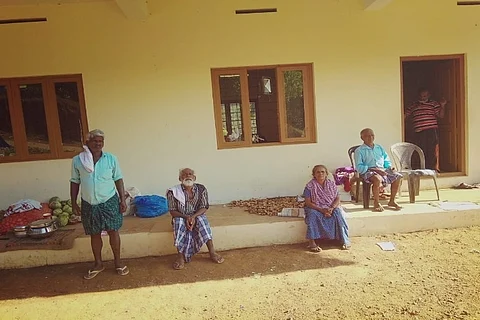No land documents or home to return to, these people still live in Kerala relief camp
When Beena Sathyan left home with her pregnant daughter, she was sure that she would be able to return home at some point.
But the frequent landslides caused by the deluge have devastated her house and shattered her dreams. Beena and her daughter Mamtha, who is seven months pregnant, have been living in a relief camp at Ponmudi under Konnathady panchayat in Idukki.
There are 30 others, many of them elderly, who have been living in the camp. There is nothing left in the place where they lived and it does not look likely that they will be able to return to where they belonged.
When thousands of others housed at various relief camps across the state returned home as the water receded, these 32 people have continued to live in relief camps for the past one month. The building, owned by the State Kudumbashree Mission, is the third camp they are staying in ever since landslips became a frequent phenomenon.
Of the 32 people from 15 families, most are from Panniyarkutty, a village that was completely wiped out in landslips, while others are from Ponmudi.
The people were first housed in a school near Panniyarkutty and later in a school in Ponmudi. But when classes resumed, they were shifted to the Kudumbashree building.
“We had a house and when we left because of the floods, we were hopeful that we would be able to return home. But now we have nowhere to go,” says Beena.
Beena and Mamtha
“Landslips also occurred in flat regions, which we never thought were prone to disaster,” says Madhu, a local who has been voluntarily assisting the people in the area.
The peculiar problem of Idukki
Some people don’t have proper documents to prove that the land was actually owned by them. The land, on which they built their houses and used to cultivate, had been handed over to them over generations. Even for the land they bought, the document they received was possession certificate, not title deed.
“I have 50 cents of land, out of which I don’t have the title deed for 10 cents,” says a member of the relief camp while another says he doesn’t have the title deed for half of the land he owns.
Most of the 32 people in the camp have the same story to share. Hence the loss is huge for them, as they have no documents to prove what land they owned, for the government to give compensation or appropriate replacement.
“The government will consider these case by case. We have to examine which are the genuine cases and which are not. If found to be genuine, necessary steps would be taken to address it,” Idukki District Collector K Jeevan Babu tells TNM.
How can people be rehabilitated?
“My daughter is pregnant, so we are planning to rent a house. But how will we be able to pay Rs 5,000 as monthly rent?” asks Beena.
The few houses available for rent in the village area are not affordable for them.
“Even if it is just one room, it is better that we have a house of our own. Our place in Panniyarkutty was entirely wiped out,” says Kutty Amma, another resident of the relief camp.
“Their rehabilitation will be possible only in a new place, but how close it is to the place they lived in is important,” says Biju EA, a teacher whose house has also been mostly damaged by the landslips. “After the floods, landslips have occurred several times,” he says.
Biju EA
“We have been witnessing it since 1983. Landslips happened in 2003 too, we struggled every time,” says Anna Kutty.
“It is not about the facilities or about how long the Kudumbashree building can be set aside for this. The problem is more about how long people from different families can be housed under one shelter,” says Madhu.
There are nearly 170 families still living in ten relief camps in the district. Rehabilitating them is a big task for the authorities. Since the government has decided that no construction will be done in the ecologically fragile zone, which are prone to landslips and where landslips have already been occurred, going back home again won’t be possible.
The authorities have to find land to rehabilitate them. “We will assist them in finding houses,” says Jeevan Babu.
“The government can’t take a decision to provide rent for a single district. The arrangement has to be made locally. We will see if there are vacant government department quarters or other buildings that locals can provide free of cost,” the Collector adds.
Livelihoods affected
Most people in the relief camps used to find work under the Mahatma Gandhi National Rural Employment Guarantee Scheme or as farm labourers or in agriculture generally. If they are forced to move to urban areas where a mass rehabilitation would be possible for authorities, finding work would be difficult for them.
“Where can we go for work at this age?” ask Pennamma and Thankappan, while Omana of Ponmudi says that she needs to find a job as a maid.

